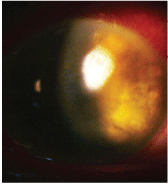 Q: Last month, you discussed differentiating between bacterial infections, non-bacterial infections and sterile events, such as contact lens-induced acute red eye (CLARE). Once I make my diagnosis, how do I determine an appropriate level of management?
Q: Last month, you discussed differentiating between bacterial infections, non-bacterial infections and sterile events, such as contact lens-induced acute red eye (CLARE). Once I make my diagnosis, how do I determine an appropriate level of management?
A: Once the condition is correctly recognized, says John Schachet, O.D., of Eyecare Consultants, Vision Source, in
A culture-proven ulcer in a contact lens wearer caused by Pseudomonas.
Remove the patient from lens wear, if he or she hasnt already done so, says Dr. Schachet. What determines the level of treatment required is the severity of the corneal involvement, including the size, location and depth of the infiltrate(s) and the state of the overlying epithelium. Is there significant anterior chamber involvement? Judge by the severity of the presentation as you see it. Every case must be treated individually.

Courtesy: Ernie Bowling, O.D.
When managing a case of bacterial keratitis, look for a drug that will achieve as high a bacterial kill count as possible, says Ernie Bowling, O.D., M.S., center director at VisionAmerica, a surgical comanagement center in Gadsden, Ala. Consider the potency and penetration of the drug, he says. The drug needs to still be effective deep into the ocular structures.
Treat patients aggressively; use a fourth-generation fluoroquinolone every 30 minutes or every hour, and then modify the regimen as needed over seven to 10 daysor longer, if necessary, says Dr. Bowling. And, he adds, depending on the severity of the case, fortified antibiotics are also an option for treatment.
A fungal infection, on the other hand, is slow to develop and hard to get rid of, Dr. Bowling says. They tend to be highly resistant to treatment, so the drug regimen will be continued over four to six weeks. Natamycin 5% is available for topical treatment, and you can prescribe an oral anti-fungal agent if the infection is very deep or if you suspect fungal endophthalmitis. Topical and oral forms of voriconazole have also been very effective in treating some fungal infections.
These cases may result in scarring when the infection quiets down. If this occurs, Dr. Schachet says, The patient will need steroid therapy to try and reduce the scar after the active portion of the infection clears.
In the case of a sterile event, such as CLARE, Dr. Schachet considers a range of therapeutic options. Im likely to use a steroid to manage it, he says. The vast majority of patients are not steroid responders, and theyre only going to be on the drug for about two weeks. Or, you could take the patient out of his or her lenses and use an artificial tear until the eyes clear. Combination steroid-antibiotic agents may also be used.
Also, recommend cool compresses, says Dr. Schachet. Cool compresses never hurt in any of these situations. If theres any lid swelling, theyll calm the eye and bring the swelling down.
Q: How can I work with the patient to try and prevent future infection?
A: An ounce of prevention is worth a pound of cure, says Dr. Bowling. We doctors need to take an active role in the education of our patients. I consider solution selection as important as a prescription. I tell patients, This is what I want you to have, and this is how I want you to use it. Patients have to understand all the risks and benefits of lens wear.
If there are any concerns, consider switching the patient to a different lens or lens care system. If the patient has a sensitivity to one solution, for example, Ill switch him or her to daily lenses or a hydrogen peroxide care system, Dr. Bowling says.

